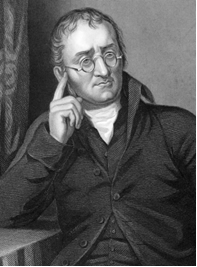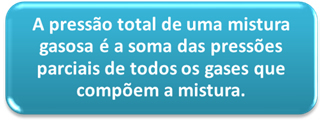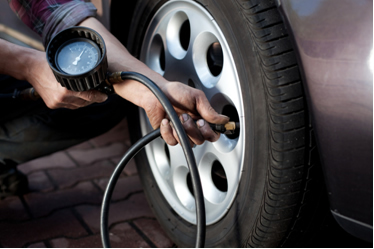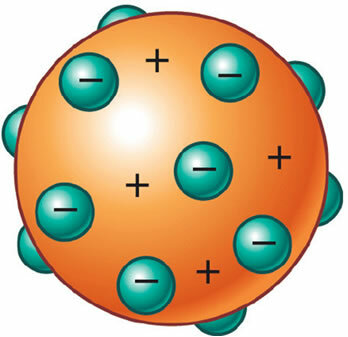John Dalton (1766-1844) was a great scholar of the constitution of matter, being best known for his atomic theory. However, he also brought many other contributions to Science. Among them is the contribution to Chemistry and Physics regarding its law established in 1801 that relates the partial pressures of gases in gaseous mixtures.

John Dalton (1766-1844)
That Dalton's Law says the following:

Generically, we have:
PTOTAL =P1 + P2 + P3 + ... or PTOTAL = ΣP
For example, let's imagine the formation of a gas mixture of helium gas and oxygen gas. Initially these two gases are in separate containers, each gas having its own volume, its own pressure and its own temperature. Then, equal volumes of these gases are mixed in a single container and kept at the same temperature.
Considering these gases as ideal, they will not react with each other, and the mixture will will behave as if it were a single gas and the pressure of each component will be independent of the pressure. of others. Therefore, the pressure of this mixture will be equal to the sum of the pressures exerted by each of its components in the mixture, that is:
PTOTAL =Phe + PO2
It is important to emphasize that the partial pressure of each gas is not the pressure it exerted before entering the mixture, when it was isolated, but it corresponds to the pressure that it would exert if it were alone, occupying the total volume of the mixture and at the same temperature at which the mixture is, that is, its pressure within the Mix.
Here's an example: Air is a gas mixture consisting basically of 80% nitrogen gas and 20% oxygen gas. Imagine that a tire is calibrated with a pressure of 2.0 atm by an air compressor. The total pressure of the mixture inside the tire is 2.0 atm. Since Dalton's law says that the total pressure is the sum of the partial pressures of each gas in the mixture, we can conclude that the The partial pressure of nitrogen gas in this mixture is 1.6 atm (80% of 2.0 atm) and that of oxygen gas is 0.4 atm (20% of 2.0 atm).

If we use the ideal gas state equation, we have that the partial pressure of each of these gases is equal to:
Phe = nheRT
V
PO2 = nO2RT
V
Do not stop now... There's more after the advertising ;)
Note that partial pressures are directly proportional to the numbers of moles (n). Thus, the total pressure is also directly proportional to the sum of the total number of moles (Σn):
PTOTAL = Σno RT
V
Through these relationships, we can determine another important chemical quantity: a molar fraction (X). It is nothing more than the relationship between the number of moles of one of the gases in the mixture and the sum of the number of moles of the mixture. This fraction also corresponds to the relationship between the partial pressure of the gas and the total pressure of the mixture.
We arrive at the molar fraction by dividing the equation of the partial pressure of one of the gases by the total pressure. Let's take helium gas as an example:
_Phe. V = nohe RT
PTOTAL. VΣn RT
Phe = nohe= Xhe
PTOTAL n
See an example: Returning to the mixture of nitrogen and oxygen present in the air with which the tire was calibrated, let's say that, for every 1 mole of air, we have 0.8 mole of nitrogen. Thus, the molar fraction of each of these gases in the mixture is given by the equations below:
XN2 = noN2 XO2 = noO2
Σno Σno
XN2 = 0.8 mol XO2 = 0.2 mol
1.0 mol 1.0 mol
XN2 = 0,8XO2 = 0,2
This could also be given by the partial pressures mentioned above:
XN2 = PN2 XO2 = PO2
PTOTAL PTOTAL
XN2 = 1.6 atm XO2 = 0.4 atm
2.0 atm 2.0 atm
XN2 = 0,8XO2 = 0,2
Note that since the molar fraction is the relationship between a partial value and a total value, the sum of all molar fractions in the mixture will always equal 1:
XN2 + Xo2 = 1
An important aspect of the partial pressures of gases is seen in our bodies. Our blood carries oxygen gas (O2) to the cells and tissues of the body and remove carbon dioxide (CO2) which is released in the breath. This exchange is facilitated by the differences in partial pressures between these gases in the blood and in the tissues, and it always occurs in the direction of the region of higher pressure to the lower pressure partial.
However, this function can be compromised in the case of climbers and divers who reach very low or very high altitudes, where the pressure of breathing oxygen changes. Hence, the importance of using suitable equipment such as oxygen-enriched compressed air cylinders.

*Editorial Credit: Sergey Goryachev / Shutterstock.com
By Jennifer Fogaça
Graduated in Chemistry
What are gases, what are the properties of gases, molecular compounds, compressibility, fixed volume, kinetic energy mean, absolute temperature of a gas, ideal gas, Real gases, perfect gas, gas state variables, volume of a gas, seasons


